Home >> Diversity and classification >> True fungi >> Dikarya >> Basidiomycota >> Pucciniomycotina >> Pucciniomycotina other than Pucciniales
PUCCINIOMYCOTINA OTHER THAN PUCCINIALES
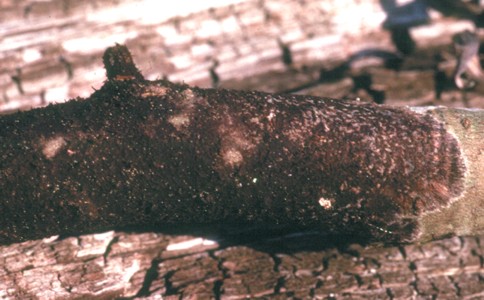
The remainder of the Pucciniomycotina, after the Pucciniales are removed, stand out as an interesting group of fungi unlike any others. Many of these have been known by mycologists for a long time and have stimulated much discussion and speculation about their relationships. Now that molecular geneticists have begun to resolve these issues we can go back for another more enlightened look.
The Septobasidiales form an order of fungi similar to the rusts but parasitic on insects rather than plants. Septobasidium curtisii figured at right is a typical member of the group. The branch in the picture was collected from a black gum tree(Nyssa sylvatica) growing in North Carolina. The darkly coloured fungal colony on the branch is S. curtisii, covering a colony of scale insects. Scale insects are members of the order Homoptera, a group of plant-feeding organisms that also includes aphids, mealybugs, whiteflies and cicadas. All have elongated tube-like mouthparts adapted to penetrating living plant tissues and sucking up liquids. Scale insects have fairly compicated life histories in which adult females become covered by a firm "shell", lose their legs and antennae and remain perminently attached to the plant. Members of the Septobasidiales grow over colonies of scale insects and penetrate a few individuals with haustoria, thus obtaining the nutrients they need. Most of the insects are not parasitized by the fungus and obtain protection from predators by the thick covering of hyphae. Some mycologists have suggested that this is a type of mutualism where the insect colony surrenders a few individuals in return for protection by the fungus.
Species of the Septobasidiales can be recognized in the field by their thick growths on living trees. They might be mistaken for lichens but are never associated with algae. Scale insects and aphids actually absorb more sugars from plants than they can use and have a means of excreting this excess as droplets of "honeydew". The honeydew attracts ants, wasps and other insects as well as fungi that grow over the sugary secretions, coating the plants and insect colonies with a dense black layer of hyphae. These sooty moulds might also be confused with Septobasidiales but rarely form such uniform smooth colonies.
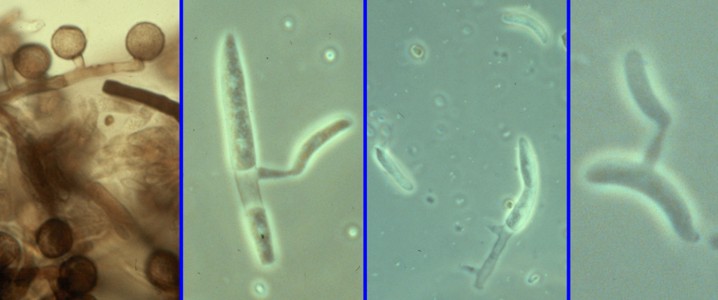
Members of the Septobasidiales produce their basidia from a layer of dark teliospores that cover the upper surface of the colony. In the leftmost panel of the picture of Septobasidium curtisii at left are several spherical teliospores that will eventually germinate to produce basidia. The next two panels show incompletely septate basidia that had become detached from the teliospore and were producing basidiospores from prominent sharp sterigmata. The final panel depicts a single basidiospore germinating to produce a similar but slightly smaller secondary spore. Germination of a spore to produce another spore is called "germination-by-repetition" or "iterative germination" and is a common feature of many Basidiomycota, particularly members of the Pucciniomycotina and Ustilaginomycotina, but even some of the Agaricomycotina. In species of Septobasidium the secondary spores are thought to adhere to the bodies of newly hatched nymphs and adult males that can carry them to uncolonized plants.
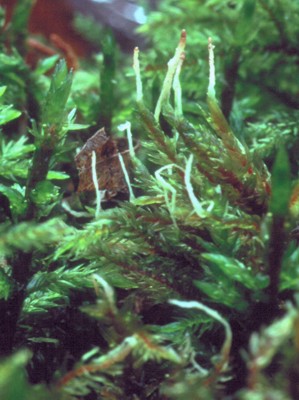
Eocronartium muscicola, shown at left, is another member of the Pucciniomycotina that you may encounter if you look carefully among carpets of moss. It is a strict parasite of mosses that is invisible to the eye until it produces its small white basidiomata at the ends of the moss branches. These basidiomata produce a layer of septate basidia resembling those shown above for Septobasidium. However, E. muscicola does not produce teliospores and instead produces basidia directly from the hyphae without any sort of resting stage. Although parasitic, this fungus does not appear to produce any disease symptoms on the moss.
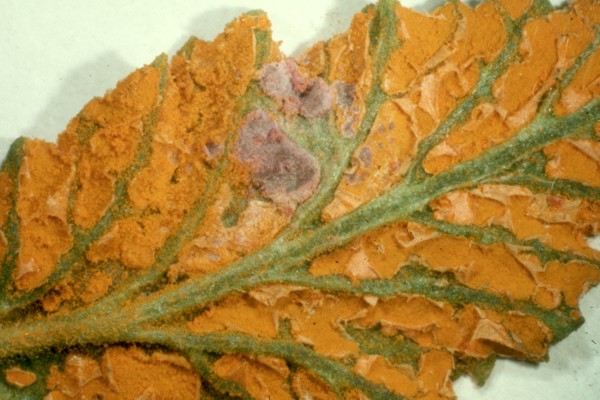
The figure at right illustrates a species of Helicobasidium yet another interesting member of the Pucciniomycotina. Drs. Robert Bauer and Matthias Lutz at the University of Tübingen in Germany have recently discovered that this fungus grows as a parasite of plant roots for part of the year but then spreads by basidiospores to the haploid (monokaryotic) stage of rust fungi at the time they are producing spermagonia. This life cycle is not unlike that of the rust fungi themselves except that the intermediate host is not a plant but another fungus. In the illustration at right a raspberry leaf is heavily infected by a rust of the genus Phragmidium. The smaller purple growth is caused by the asexual stage of a Helicobasidium species, a fungus long-known under the name Tuberculina persicina. The fact that this fungus has a heteroxenous life history involving hosts in different kingdoms (plant and fungus) is unexpected and very unusual.
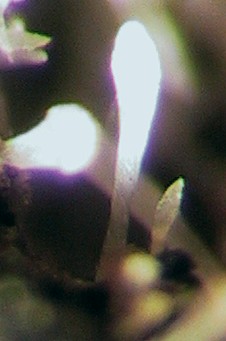
All of the fungi discussed so far on this page have been members of the Pucciniomycetes, a class that includes the rust fungi as well. However, the Pucciniomycotina contains several other classes whose members are less well-known and are rarely seen by even the most experienced mycologists. One of these classes, the Agaricostilbomycetes, is probably not very large in numbers of species but is remarkably diverse. Molecular biologists have now shown that the Agaricostilbomycetes is more diverse than the Pucciniomycetes, containing at least six orders. Stilbum vulgare, the fungus illustrated at left, is a member of one of these orders, the Agaricostilbales. It occurs on rotting wood where it is probably living as a parasite on other fungi. The basidia occupy the swollen white part of the basidioma. The fungus in the photo was found growing inside an insect tunnel in very old wood collected in February in northern Ontario. The wood was brought back to the lab, thawed and placed in a covered container where it could begin to grow again.
The Microbotryales, another order in the Agaricostilbomycetes, are one more surprise given to us by molecular biology. Some of these fungi are called "anther smuts" because they closely resemble the smut fungi and have been traditionally classified among them. They occur on the anthers of flowering plants and are carried from flower to flower by pollinating insects. Microbotryum violaceum is commonly found on the anthers of members of the pink family (Caryophyllaceae), particularly the genus Silene.
Home >>
Diversity and classification >>
True fungi >>
Dikarya >>
Basidiomycota >>
Pucciniomycotina >>
Pucciniomycotina other than Pucciniales